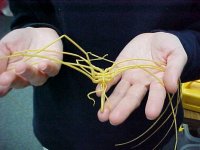 Weird spider-like creatures that live at the bottom of the ocean and use a straw to suck on their prey are baffling scientists.
Weird spider-like creatures that live at the bottom of the ocean and use a straw to suck on their prey are baffling scientists. These sea spiders, some of which are blind, have so far defied scientific classification.
Marine zoologist Dr Claudia Arango of the Australian Museum in Sydney says they are arthropods, but she is unsure of their type.She presented her research on these unusual and poorly understood animals recently at the Scientific Committee on Antarctic Research (SCAR) meeting in Hobart."They are very weird looking animals," Dr Arango said.
For over 100 years, scientists have been puzzling over how exactly to classify pycnogonids - or sea spiders as they are more commonly known. They crawl along the bottom of the sea floor, sometimes more than 6,000 to 7,000 metres down. There they live in the dark and feed on slow-moving, soft-bodied sponges and sea slugs.
Dr Arango says the creatures are segmented and have an exoskeleton, which makes them an arthropod - the same grouping as crustaceans, insects, centipedes and spiders. But she says they also have a very strange collection of features, including a unique feeding structure.
"They have a proboscis that's like a straw that they insert into the animals and suck out the juices," Dr Arango said.She says such features make it difficult to fit them into any of the known groups of arthropods. "They look like spiders, but they are not real spiders," she said. "It's been very hard to place them in a position within the tree of life."
Dr Arango has been studying the diversity and evolution of sea spiders. She has been using DNA and morphology to construct a family tree, using 60 species of sea spiders from all over the world.Some scientists believe that sea spiders make up a new very primitive group at the base of the arthropod family tree.
But Dr Arango's findings so far support another theory - that they are more closely related to the arthropod group that includes spiders and scorpions. She says these are only preliminary conclusions and the jury remains out. Dr Arango says the most interesting sea spiders live in Antarctica. They are more diverse, more abundant, bigger and weirder than other sea spiders.
"That makes them a very sexy and attractive fauna," she said.
One type of Antarctic sea spider has an extra body segment, giving them five pairs of legs instead of the usual four pairs. Another type has extremely long legs spanning 70 centimetres.
Dr Arango says the diversity and abundance of sea spiders in Antarctica means they probably play a very important role in its ecology, although this is yet to be elucidated.
Her research has been accepted for publication in the journal Cladistics.
2 comments:
their aliens..put them down or they will suck you dry....
I see a movie .... hahaha !
Post a Comment